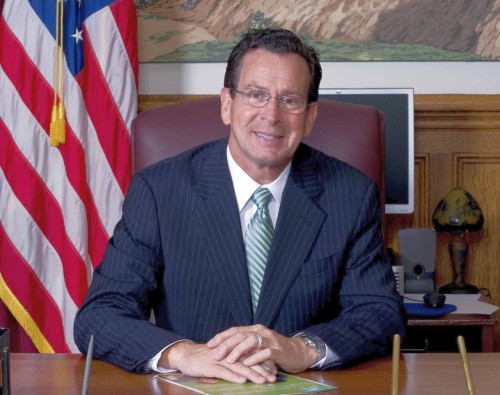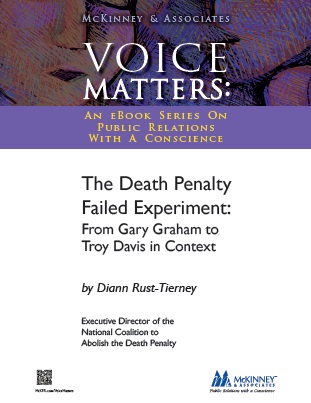
Commentary from nationally syndicated columnist
E.J. Dionne (pictured) and the
New York Times reflected on the changing state of the death penalty in the U.S. in light of recent developments. Dionne cited the repeal of the death penalty in
Connecticut as an example of a "remarkable pivot in the politics of the death penalty, the premier issue on which an overwhelming consensus favoring what’s taken to be the conservative side has begun to crumble." He observed that "significant groups of libertarian Republicans and opponents of abortion have crossed to the repeal side." In an editorial titled "The Myth of Deterrence," the
New York Times noted that "a distinguished committee of scholars working for the National Research Council has now reached the striking and convincing conclusion that all of the research about deterrence and the death penalty done in the past generation . . . should be ignored." The
Times concluded that other states should follow Connecticut’s lead in repealing the death penalty.
Read full texts below.
Little Connecticut’s big message on the death penalty
By E.J. Dionne Jr., April 29, 2012
Since the 2010 elections, newly empowered conservative and Republican state legislatures have gained national attention with their wars on public employee unions, additional restrictions on abortion and new barriers to voting.
Against this backdrop, the little state of Connecticut has loomed as a large progressive exception. Last year, it became the first state to require employers to grant paid sick leave. It also enacted a law granting in-state tuition to students whose parents brought them to the United States illegally as young children.
And last week, Connecticut Gov. Dan Malloy signed a law repealing the state’s death penalty. There are now 17 states without capital punishment, Illinois having joined the ranks last year. What happened in Connecticut brings home the flaw in seeing everything that has happened in the states since the midterm vote as embodying a steady shift rightward.
Where they hold power, progressives have also been using their states as laboratories, and Malloy is part of an impressive group of mostly smaller-state Democratic governors who have combined a moderate, business-friendly style with progressive policymaking. Their ranks include, among others, Govs. Jack Markell in Delaware, Martin O’Malley in Maryland, John Hickenlooper in Colorado, Deval Patrick in Massachusetts and outgoing Gov. John Lynch in New Hampshire.
After the 2012 election, a key front in the battle for America’s political future will involve how the various left and right experiments in the states are judged. Aggressive conservatives such as Govs. Scott Walker in Wisconsin and John Kasich in Ohio are in the headlines now, and the recall Walker faces will keep him there for a while. But there will be a quieter and more comprehensive reckoning down the road.
Part of this reckoning will be a remarkable pivot in the politics of the death penalty, the premier issue on which an overwhelming consensus favoring what’s taken to be the conservative side has begun to crumble.
In the 1980s and ‘90s, capital punishment was a staple of Republican campaigns against a handful of liberals who bravely stuck with their opposition to the ultimate punishment. George H.W. Bush used the issue effectively against Democrat Mike Dukakis in the 1988 presidential campaign. Republicans also used it in their 1994 electoral sweep, notably in defeating three-term Democratic Gov. Mario Cuomo in New York. And no wonder: In 1994, support for the death penalty hit its peak of 80 percent nationwide.
But a Gallup survey last fall showed how much things have changed: Support for capital punishment was down to 61 percent. Among the many reasons for the drop are a decline in crime rates, which has increased public confidence in the criminal justice system, and a stream of reports casting doubt on the guilt of some who were executed. In addition, significant groups of libertarian Republicans and opponents of abortion have crossed to the repeal side. An important test of the new politics of capital punishment will come this November in a California death penalty referendum.
For all this, it still takes political courage to end capital punishment. A Quinnipiac University poll released last week as Malloy signed the death penalty repeal found 62 percent of Connecticut voters still favoring executions of those convicted of murder, with only 30 percent opposed. Just 29 percent of those queried approved of the legislature’s handling of the issue, while 51 percent disapproved.
But (and it’s a very important but) support for the death penalty, in Connecticut and elsewhere, is not as robust as it looks. When Quinnipiac posed a different question — “Which punishment do you prefer for people convicted of murder, the death penalty, or life in prison with no chance of parole?” — only 46 percent favored the death penalty. An equal number chose life without parole. Death penalty opponents have an opening they haven’t had for some time.
Moreover, voters aren’t as agitated by the issue as they once were. Only 37 percent of Connecticut voters told Quinnipiac that the issue would be “extremely” or “very” important to how they cast their ballots in legislative elections.
Malloy is under no illusions about the strong residual opposition to repeal. When he signed the repeal bill last Wednesday, he did so with little ceremony, carefully observing that “many people whom I deeply respect, including friends and family ... believe the death penalty is just.”
Nonetheless, what Malloy did was historic, and it was a sign that despite the dreary polarization that characterizes our debates, American politics is still capable of springing surprises.
The Myth of Deterrence
Editorial, N.Y. Times - April 28, 2012
One of the most frequently made claims about the death penalty is that it deters potential murderers. That was the claim when the Supreme Court reinstated capital punishment in 1976. It is the claim today after a revival of research about the topic in the last decade.
But a distinguished committee of scholars working for the National Research Council has now reached the striking and convincing conclusion that all of the research about deterrence and the death penalty done in the past generation, including by some first-rank scholars at the most prestigious universities, should be ignored.
The committee found that the research “is not informative about whether capital punishment increases, decreases, or has no effect on homicide rates.” No study looks at what really matters, by comparing the deterrent effects of capital punishment with other penalties, like life without parole. A lot of the research assumes that “potential murderers respond to the objective risk of execution,” but only one in six of the people sentenced to death in the last 35 years have been executed and no study properly took that diminished risk into account.
“Nothing is known about how potential murderers actually perceive their risk of punishment,” said the criminologist Daniel Nagin, chairman of the committee.
The committee was careful to say what it did not examine, including the proven risk that an innocent person could be sentenced to death and the fact that the administration of capital punishment could well be discriminatory.
On Wednesday when Connecticut’s governor, Dannel Malloy, signed the state’s new law abolishing the death penalty, these problems were on his mind. As a former supporter of capital punishment, he said that he “came to believe that doing away with the death penalty was the only way to ensure it would not be unfairly imposed.”
The 33 states that retain the death penalty should follow that lead.
(E.J. Dionne, "
Little Connecticut’s big message on the death penalty," Washington Post, April 29, 2012; "
The Myth of Deterrence," New York Times, editorial, April 28, 2012). See
Deterrence and
Public Opinion. Read more
Editorials. Listen to DPIC's
podcast on Deterrence.

 On April 25, Connecticut Governor Dannel Malloy (pictured) signed into law a bill that replaces the death penalty with life without parole. Connecticut is the fifth state in five years, and the 17th overall, to do away with capital punishment. Governor Malloy, who once supported the death penalty, offered the following statement: “My position on the appropriateness of the death penalty in our criminal justice system evolved over a long period of time. As a young man, I was a death penalty supporter. Then I spent years as a prosecutor and pursued dangerous felons in court, including murderers. In the trenches of a criminal courtroom, I learned firsthand that our system of justice is very imperfect. While it’s a good system designed with the highest ideals of our democratic society in mind, like most of human experience, it is subject to the fallibility of those who participate in it. I saw people who were poorly served by their counsel. I saw people wrongly accused or mistakenly identified. I saw discrimination. In bearing witness to those things, I came to believe that doing away with the death penalty was the only way to ensure it would not be unfairly imposed." See more of the governor's statement below.
On April 25, Connecticut Governor Dannel Malloy (pictured) signed into law a bill that replaces the death penalty with life without parole. Connecticut is the fifth state in five years, and the 17th overall, to do away with capital punishment. Governor Malloy, who once supported the death penalty, offered the following statement: “My position on the appropriateness of the death penalty in our criminal justice system evolved over a long period of time. As a young man, I was a death penalty supporter. Then I spent years as a prosecutor and pursued dangerous felons in court, including murderers. In the trenches of a criminal courtroom, I learned firsthand that our system of justice is very imperfect. While it’s a good system designed with the highest ideals of our democratic society in mind, like most of human experience, it is subject to the fallibility of those who participate in it. I saw people who were poorly served by their counsel. I saw people wrongly accused or mistakenly identified. I saw discrimination. In bearing witness to those things, I came to believe that doing away with the death penalty was the only way to ensure it would not be unfairly imposed." See more of the governor's statement below. A new book published in electronic format, The Death Penalty Failed Experiment: From Gary Graham to Troy Davis in Context by Diann Rust-Tierney, examines the problem of arbitrariness in the death penalty since its reinstatement in 1976. Through an analysis of the cases of Gary Graham and Troy Davis, the author argues that race, wealth and geography play a more significant role in determining who faces capital punishment than the facts of the crime itself. Both defendants had significant claims of innocence; both were black defendants who were ultimately executed in the South; in both cases, the victim in the underlying murder was white. Graham was executed in Texas in 2000 and Davis was executed in Georgia in 2011. Rust-Tierney writes, “How do you administer the most severe punishment imaginable in a manner that is accurate, free from bias and demonstrably fair? Until we are all seen and treated as equal, we cannot afford to keep capital punishment.” Ms. Rust-Tierney is an attorney and Executive Director of the National Coalition to Abolish the Death Penalty.
A new book published in electronic format, The Death Penalty Failed Experiment: From Gary Graham to Troy Davis in Context by Diann Rust-Tierney, examines the problem of arbitrariness in the death penalty since its reinstatement in 1976. Through an analysis of the cases of Gary Graham and Troy Davis, the author argues that race, wealth and geography play a more significant role in determining who faces capital punishment than the facts of the crime itself. Both defendants had significant claims of innocence; both were black defendants who were ultimately executed in the South; in both cases, the victim in the underlying murder was white. Graham was executed in Texas in 2000 and Davis was executed in Georgia in 2011. Rust-Tierney writes, “How do you administer the most severe punishment imaginable in a manner that is accurate, free from bias and demonstrably fair? Until we are all seen and treated as equal, we cannot afford to keep capital punishment.” Ms. Rust-Tierney is an attorney and Executive Director of the National Coalition to Abolish the Death Penalty.  In a recent op-ed in the Atlanta Journal-Constitution, former U.S. President Jimmy Carter called for the end of the death penalty. President Carter cited the risk of wrongful executions, the lack of evidence of deterrence, and the costs of prosecution as reasons to abolish capital punishment. He wrote, “[T]here has never been any evidence that the death penalty reduces capital crimes or that crimes increased when executions stopped. Tragic mistakes are prevalent. DNA testing and other factors have caused 138 death sentences to be reversed since I left the governor’s office. The cost for prosecuting executed criminals is astronomical. Since 1973, California has spent roughly $4 billion in capital cases leading to only 13 executions, amounting to about $307 million each.” President Carter also cited the unfair application of the death penalty as an especially compelling reason for repeal: “Perhaps the strongest argument against the death penalty is extreme bias against the poor, minorities or those with diminished mental capacity. Although homicide victims are six times more likely to be black rather than white, 77 percent of death penalty cases involve white victims. Also, it is hard to imagine a rich white person going to the death chamber after being defended by expensive lawyers. This demonstrates a higher value placed on the lives of white Americans.” Read full op-ed below.
In a recent op-ed in the Atlanta Journal-Constitution, former U.S. President Jimmy Carter called for the end of the death penalty. President Carter cited the risk of wrongful executions, the lack of evidence of deterrence, and the costs of prosecution as reasons to abolish capital punishment. He wrote, “[T]here has never been any evidence that the death penalty reduces capital crimes or that crimes increased when executions stopped. Tragic mistakes are prevalent. DNA testing and other factors have caused 138 death sentences to be reversed since I left the governor’s office. The cost for prosecuting executed criminals is astronomical. Since 1973, California has spent roughly $4 billion in capital cases leading to only 13 executions, amounting to about $307 million each.” President Carter also cited the unfair application of the death penalty as an especially compelling reason for repeal: “Perhaps the strongest argument against the death penalty is extreme bias against the poor, minorities or those with diminished mental capacity. Although homicide victims are six times more likely to be black rather than white, 77 percent of death penalty cases involve white victims. Also, it is hard to imagine a rich white person going to the death chamber after being defended by expensive lawyers. This demonstrates a higher value placed on the lives of white Americans.” Read full op-ed below. Commentary from nationally syndicated columnist E.J. Dionne (pictured) and the New York Times reflected on the changing state of the death penalty in the U.S. in light of recent developments. Dionne cited the repeal of the death penalty in Connecticut as an example of a "remarkable pivot in the politics of the death penalty, the premier issue on which an overwhelming consensus favoring what’s taken to be the conservative side has begun to crumble." He observed that "significant groups of libertarian Republicans and opponents of abortion have crossed to the repeal side." In an editorial titled "The Myth of Deterrence," the New York Times noted that "a distinguished committee of scholars working for the National Research Council has now reached the striking and convincing conclusion that all of the research about deterrence and the death penalty done in the past generation . . . should be ignored." The Times concluded that other states should follow Connecticut’s lead in repealing the death penalty. Read full texts below.
Commentary from nationally syndicated columnist E.J. Dionne (pictured) and the New York Times reflected on the changing state of the death penalty in the U.S. in light of recent developments. Dionne cited the repeal of the death penalty in Connecticut as an example of a "remarkable pivot in the politics of the death penalty, the premier issue on which an overwhelming consensus favoring what’s taken to be the conservative side has begun to crumble." He observed that "significant groups of libertarian Republicans and opponents of abortion have crossed to the repeal side." In an editorial titled "The Myth of Deterrence," the New York Times noted that "a distinguished committee of scholars working for the National Research Council has now reached the striking and convincing conclusion that all of the research about deterrence and the death penalty done in the past generation . . . should be ignored." The Times concluded that other states should follow Connecticut’s lead in repealing the death penalty. Read full texts below.


